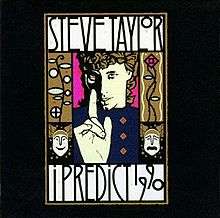I Predict 1990
I Predict 1990 is the title of the fourth release and third full-length album by singer-songwriter Steve Taylor. Lyrically, the album explores actions that exploit others to various ends from multiple perspectives. CCM magazine found that the overall theme is that the ends never justify the means.[2] It was released as a one-off on Myrrh Records instead of Sparrow. Taylor has said that the album's title was meant as a parody of a Lester Sumrall TV program and book, I Predict 1986.[3]
| I Predict 1990 | ||||
|---|---|---|---|---|
 | ||||
| Studio album by | ||||
| Released | 1987 | |||
| Studio |
| |||
| Genre | Rock | |||
| Length | 43:44 | |||
| Label | Myrrh | |||
| Producer | The Beaufort Twins Dave Perkins and Steve Taylor | |||
| Steve Taylor chronology | ||||
| ||||
| Review scores | |
|---|---|
| Source | Rating |
| AllMusic | |
| CCM Magazine | (not rated)[2] |
Background
The cover was designed and painted by Taylor's wife, Debi. It was intended to resemble early 20th-century French poster art; however some Christians felt that it resembled a tarot card, which sparked controversy. Additionally, one televangelist claimed that the image was of Taylor saluting Satan,[4] and that it additionally contained secret messages and links to New Age philosophy.[4] These accusations caused some Christian book stores to pull the album.[5][6]
Per the album's credits, all songs were written by Steve Taylor, except "Babylon" by Taylor and Dave Perkins. The ending theme to "Jim Morrison's Grave" was "borrowed" from Claude Debussy; and the introduction to "Harder to Believe" was "stolen" from Sergei Rachmaninoff.[7]
The song "I Blew Up the Clinic Real Good" proved controversial; The song's lyrics - a scathing critique of anti-abortion activists who in turn blow up abortion clinics or kill doctors - resulted in Christian bookstores pulling the album, either because the song's critique of the pro-life movement offended store owners and customers, or because these same individuals missed the song's satirical point, and believed Taylor advocated such violence. Taylor himself would occasionally call these stores to personally explain the song to them.[8] Taylor's tour of Australia was canceled due to the controversy around "I Blew Up The Clinic Real Good", largely due to misunderstanding of its satire.[4]
Disillusioned with the Christian music scene following these and other controversies during the course of his career, Taylor formed the secular alternative rock band Chagall Guevara shortly after the release of the album.[9]
Track listing
- "I Blew Up the Clinic Real Good" - 4:12
- "What Is the Measure of Your Success?" - 4:39
- "Since I Gave Up Hope I Feel a Lot Better" - 3:29
- "Babylon" - 4:51
- "Jim Morrison's Grave" - 4:29
- "Svengali" - 4:30
- "Jung and the Restless" - 4:32
- "Innocence Lost" - 5:03
- "A Principled Man" - 3:27
- "Harder to Believe Than Not To" - 4:32
Personnel
Some Band
- Steve Taylor – vocals and backup percussion
- Dave Thrush – saxophones
- Jeff Stone – guitar
- Glen Holmen – bass
- Jack Kelly – drums
- Steve Goomas – keyboards
- Gym Nicholson – guitar
Additional musicians
- Dave Perkins – additional guitar on all songs except "Jim Morrison's Grave" and "Harder to Believe"
- Greg Husted – assorted keyboard tracks and accordion
- Papa John Creach – fiddle
- Ashley Cleveland – vocal stylings on "Jim Morrison's Grave", "Svengali", and "Babylon"
- Annie McCaig – backing vocals on "Success" and "A Principled Man"
- Nathan East: bass on "Clinic"
- Gary Lunn – bass on "Hope"
- Lisa Cates – percussion
- Mike Mead – more percussion
- Mary Bates – operatic vocal on "Harder to Believe"
- Jim Horn – tenor sax on "Clinic"
- Ross Holmen – French horn
- John Andrew Schreiner – synth bass on "Svengali"
- Janet Croninger – "Jung" woman
- Fred Travalena – "Jung" doctor
- Del Newman – orchestration on "Harder to Believe Than Not To"
Production notes
- The Beaufort Twins (Dave Perkins and Steve Taylor) - producers and engineers
- Dave Perkins - producer, engineer, mixing
- Steve Taylor - producer, mixing
- David Schober - engineer
- Malcom Harper - engineer
- Robert Wartinbee - assistant engineer
- Michael Ross - engineer on "Harder To Believe"
- Music Grinder, Los Angeles, California - recording location
- Reelsound Bus, Nashville, Tennessee - recording location
- Wayne Cook Studios, Los Angeles, California - recording location
- CBS Studios, London - recording location
- Reelsound truck, Austin, Texas (48 track) - mixing location
- Bob Ludwig - mastering
- Masterdisk, New York, New York - mastering location
- Dave Perkins and Steve Taylor are listed as producers as "The Beaufort Twins." A likely satire of the Mick Jagger & Keith Richards production/songwriting partnership billed as The Glimmer Twins
References
- I Predict 1990 at AllMusic
- Brown, Bruce A. (January 1988). "Reviews: I Predict 1990". CCM Magazine. 10 (7): 34, 36. ISSN 1524-7848.
- Chattaway, Peter (1997). "Steve Taylor Interview =".
- Peterson, Doug (Jan–Feb 1996). "Door Magazine, This Is Your Life! Revisiting Past Graduates of The Door Interview, Part 5". The Whittenburg Door (145). ISSN 1044-7512.
- Powell, Mark Allan (2002). "Steve Taylor". Encyclopedia of Contemporary Christian Music (First printing ed.). Peabody, Massachusetts: Hendrickson Publishers. p. 931. ISBN 1-56563-679-1.
- Gibson, Sarah Edith (2009). Behind the Scenes of the Steve Taylor Story: A Documentary (PDF) (MFA thesis). University of North Texas. p. 6.
- Bredehoft, John E. (2010-02-22). "Jim Morrison's Grave (the Steve Taylor song) and Kurt Cobain". Empoprise-MU. Retrieved 2016-05-31.
- Encyclopedia of Contemporary Christian Music; Powell; p931; Hendrickson Publishers; paperback edition (August 2002)
- "Steve Taylor Interview".